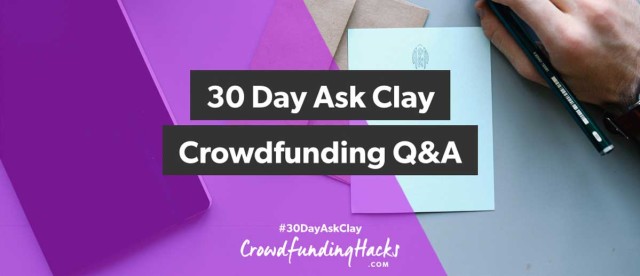This is the eleventh post in our 30 Day Ask Clay Crowdfunding Q&A.
I’m answering a new question every day in June.
Submit your question by going to CrowdfundingHacks.com/AskClay, where you can see all of the questions and all of my answers.
Full Transcript
Hey everyone…this is Clay Hebert from CrowdfundingHacks.com…and today’s question is…
Why do crowdfunding projects succeed or fail?
This is obviously a great question and one that’s on the mind of everyone doing a crowdfunding campaign.
Well, there are really only two reasons any crowdfunding project succeeds or fails. Yes, it’s really only two reasons.
- Traffic and
- Conversion
Traffic is simply how many people visit your page. I have yet to see anyone successfully back a crowdfunding campaign without first seeing it.
Conversion is the percentage of those people who back your project and actually pay you.
Another way to think about this that’s a little easier to remember and a little more mnemonic is “Play” and “Pay”.
Play is how many people “play” your video.
Pay is how many people pay, or back the project.
What impacts traffic? What impacts conversion?
There are essentially seven things that impact traffic and seven things that impact conversion.
The 7 things that impact traffic are:
- The permission asset (often an email list) that you build before you launch your campaign
- Social media
- Social sharing
- Organic traffic
- Paid traffic
- Platform traffic
- Press (listed last for a reason)
The 7 things that impact conversion are:
- Your product
- Marketing to the right people
- Your story (told via your video)
- Your rewards and pricing (and their relative value)
- Social proof
- Press
- Progress + momentum
The traffic fallacy
I’ve seen projects succeed or fail because of every single combination of traffic and conversion, but I want to explain one of the biggest mistakes I see creators make.
Most creators think they need more traffic. They’re wrong.
Most creators need better conversion.
Let’s look at a simple example
Let’s say your campaign has a funding goal of $30,000.
If your average contribution per backer is $30 and your campaign converts at 10%, meaning 10 out of every 100 people who view your campaign, actually back your campaign, you only need 10,000 total views of your campaign. The math is pretty simple…
10,000 views * 10% conversion = 1,000 backers at an average of $30 per backer = $30,000
Now let’s say everything else is the same, but your campaign only converts at 2%, meaning 2 out of every 100 people who view your campaign, actually back it. Now, you need 50,000 views of your campaign. Again, the math is…
50,000 views * 2% conversion = 1,000 backers at an average of $30 per backer = $30,000
So the lesson is, if your campaign converts well, say at 10% vs. 2%, you need a lot less traffic.
More traffic with poor conversion is like water through a sieve.
And it’s much easier to pull the levers to optimize the elements that impact conversion (ideally before you launch) than it is to scramble to get more traffic.
As always, you can submit your question or see all of the crowdfunding questions and my answers at http://crowdfundinghacks.com/AskClay
End Transcript
